Abstract
The antimicrobial activity of ofloxacin was tested against 15 standard strains and 37 clinical and environmental strains of Legionella pneumophila by agar dilution susceptibility studies with a new growth medium. The ofloxacin MICs were inoculum dependent and ranged from 0.03 to 0.125 microgram/ml. The antibacterial activities of other agents tested relative to ofloxacin were rifampin greater than ofloxacin greater than josamycin greater than pipemidic acid. Ofloxacin, at concentrations equal to or greater than 0.05 microgram/ml, inhibited the growth of L. pneumophila grown in human monocytes. The therapeutic efficacy of ofloxacin in experimental guinea pig L. pneumophila pneumonia was greater than that observed with erythromycin or josamycin therapy; it was less effective than was rifampin. Ofloxacin was very active against intracellular L. pneumophila in these experiments and should be studied in the therapy of human Legionnaires disease.
Full text
PDF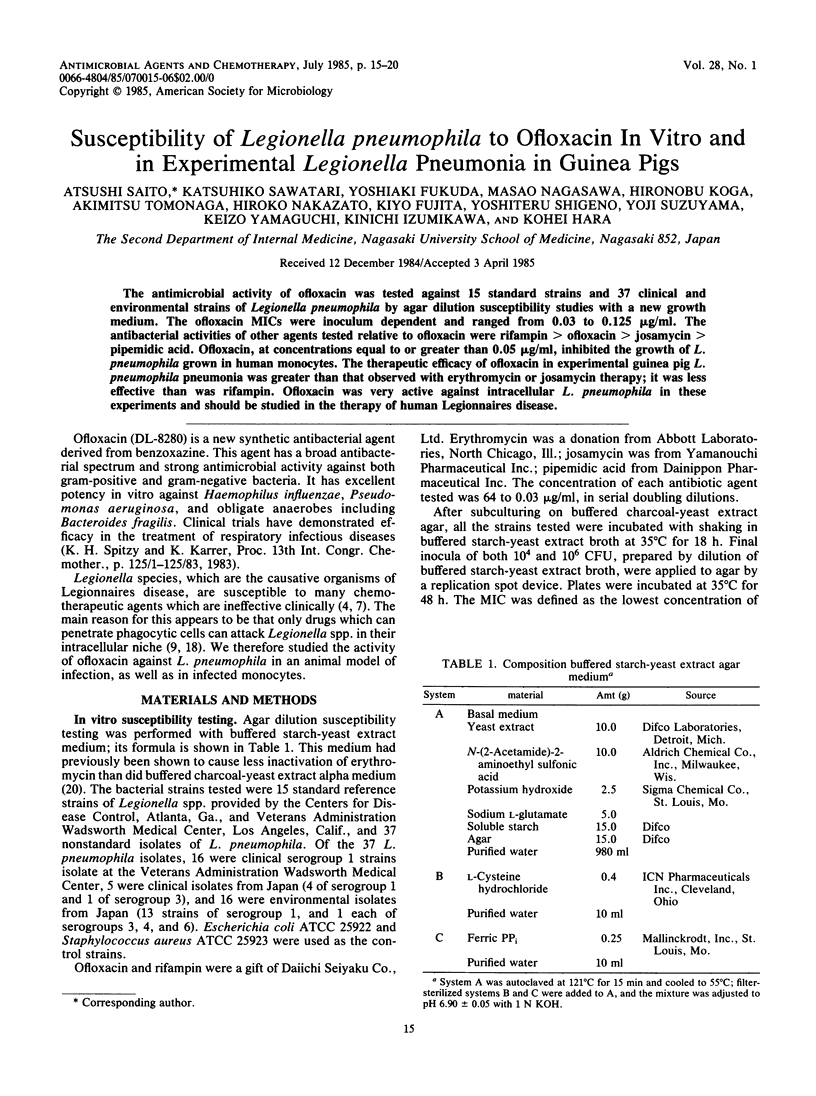
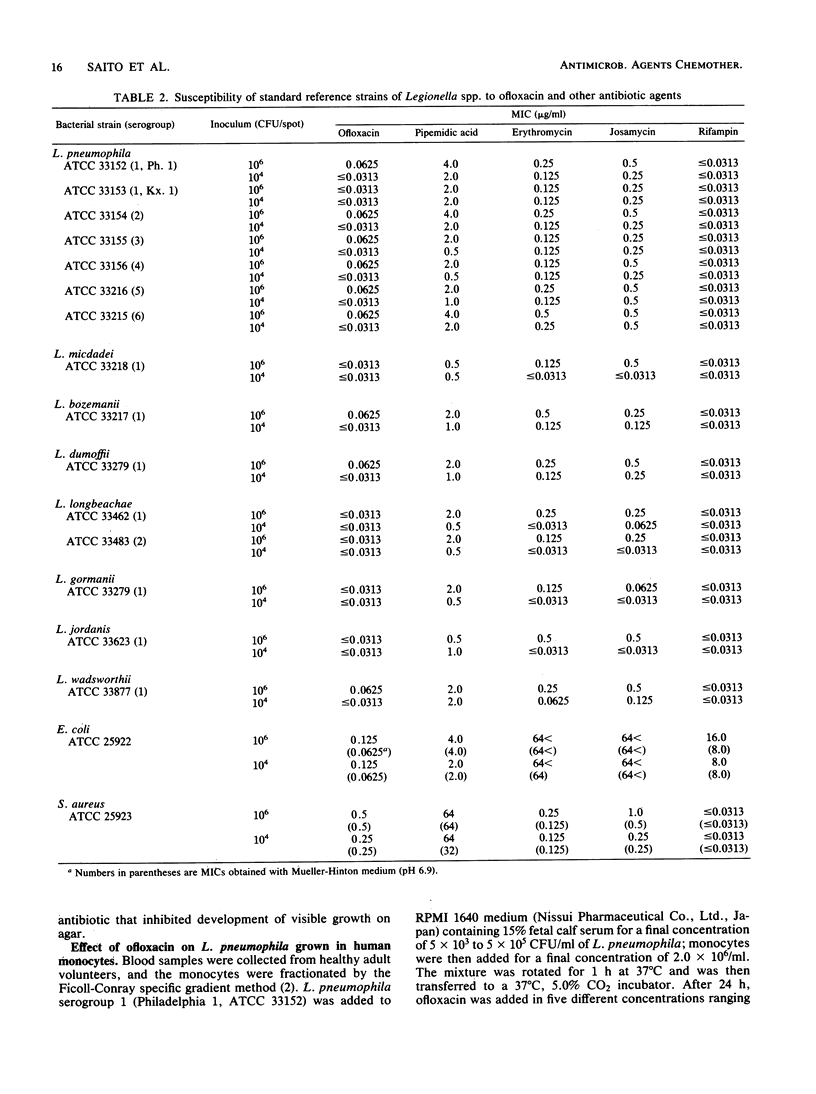
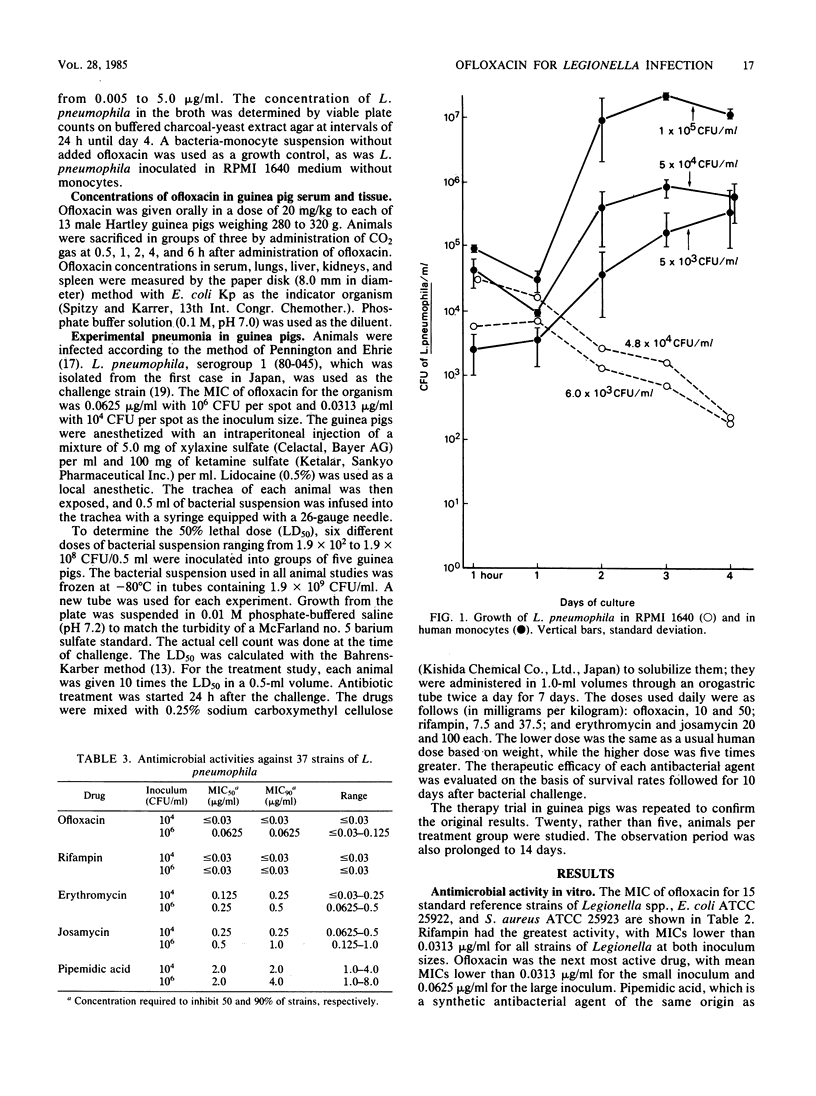
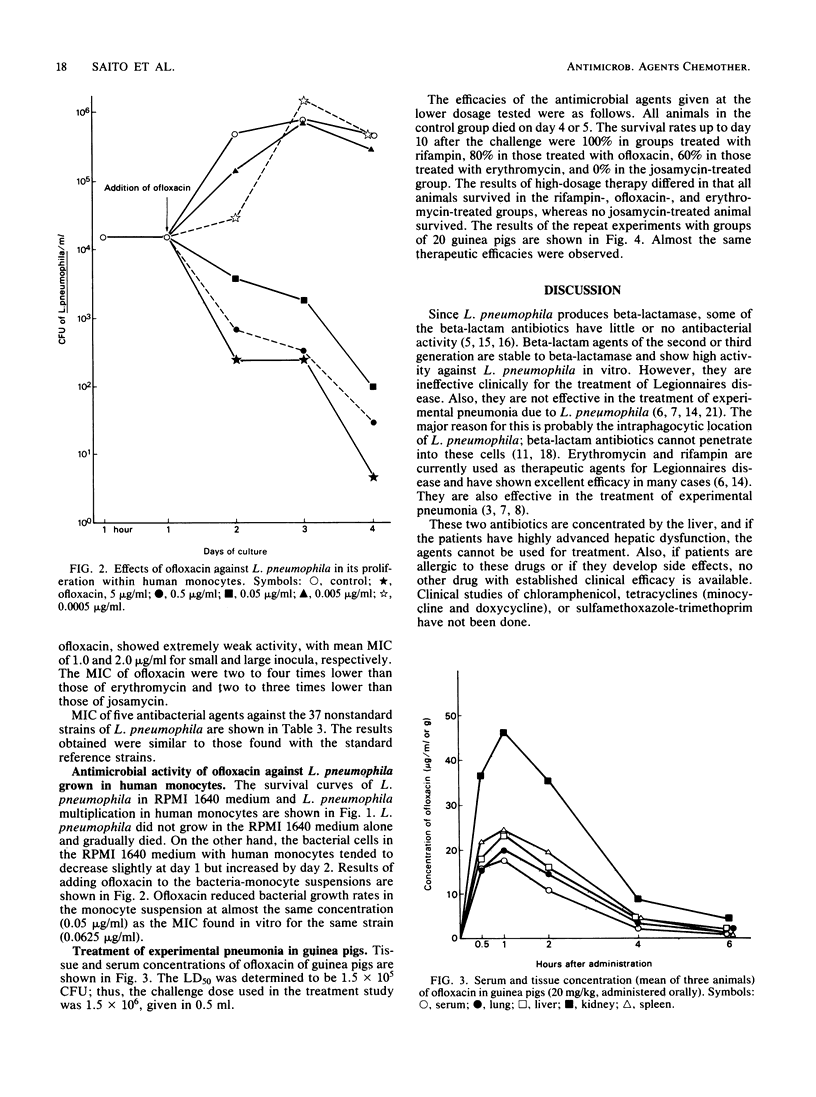
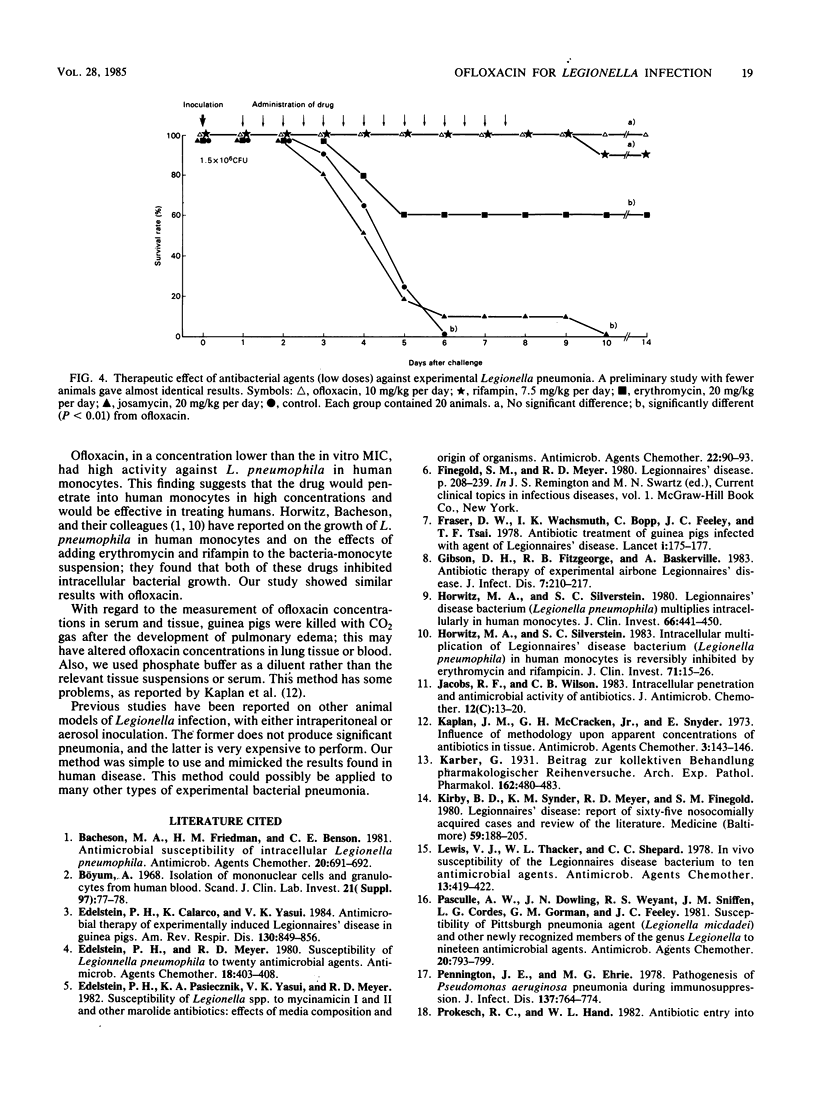
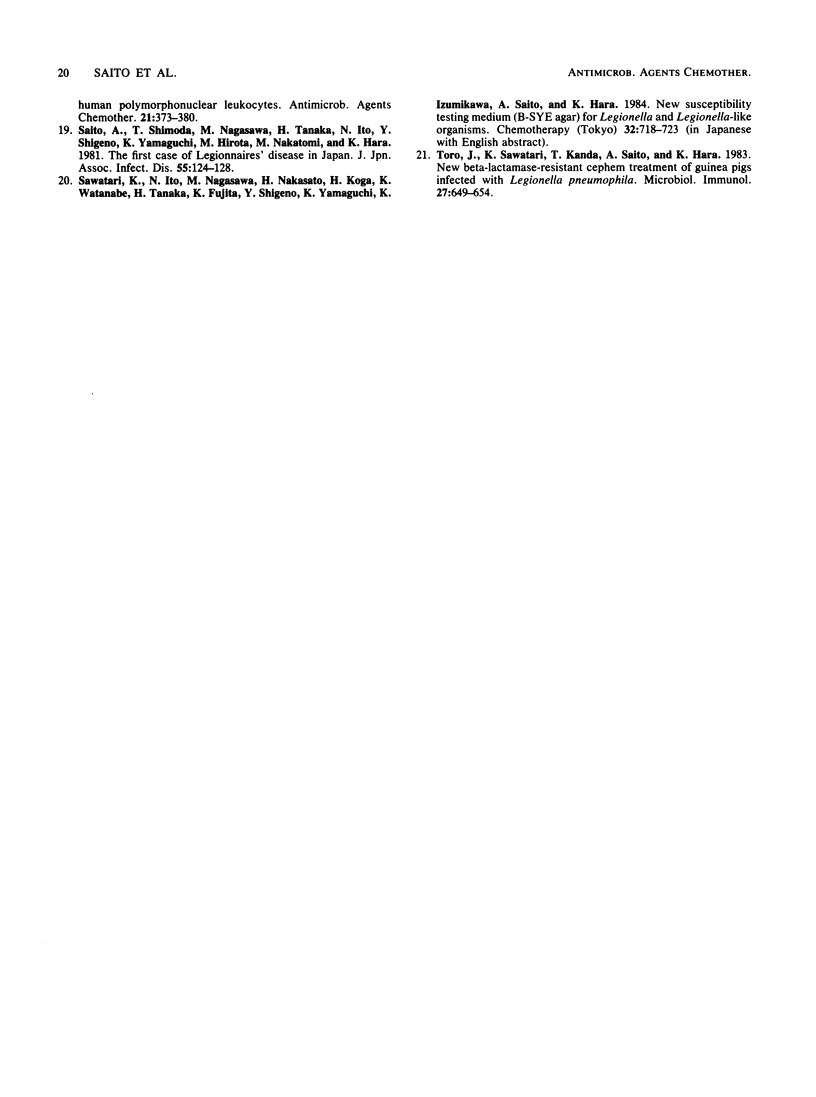
Selected References
These references are in PubMed. This may not be the complete list of references from this article.
- Bacheson M. A., Friedman H. M., Benson C. E. Antimicrobial susceptibility of intracellular Legionella pneumophila. Antimicrob Agents Chemother. 1981 Nov;20(5):691–692. doi: 10.1128/aac.20.5.691. [DOI] [PMC free article] [PubMed] [Google Scholar]
- Böyum A. Isolation of mononuclear cells and granulocytes from human blood. Isolation of monuclear cells by one centrifugation, and of granulocytes by combining centrifugation and sedimentation at 1 g. Scand J Clin Lab Invest Suppl. 1968;97:77–89. [PubMed] [Google Scholar]
- Edelstein P. H., Calarco K., Yasui V. K. Antimicrobial therapy of experimentally induced Legionnaires' disease in guinea pigs. Am Rev Respir Dis. 1984 Nov;130(5):849–856. doi: 10.1164/arrd.1984.130.5.849. [DOI] [PubMed] [Google Scholar]
- Edelstein P. H., Meyer R. D. Susceptibility of Legionella pneumophila to twenty antimicrobial agents. Antimicrob Agents Chemother. 1980 Sep;18(3):403–408. doi: 10.1128/aac.18.3.403. [DOI] [PMC free article] [PubMed] [Google Scholar]
- Edelstein P. H., Pasiecznik K. A., Yasui V. K., Meyer R. D. Susceptibility of Legionella spp. to mycinamicin I and II and other macrolide antibiotics: effects of media composition and origin of organisms. Antimicrob Agents Chemother. 1982 Jul;22(1):90–93. doi: 10.1128/aac.22.1.90. [DOI] [PMC free article] [PubMed] [Google Scholar]
- Fraser D. W., Wachsmuth I., Bopp C., Feeley J. C., Tsai T. F. Antibiotic treatment of guinea-pigs infected with agent of Legionnaires' disease. Lancet. 1978 Jan 28;1(8057):175–178. doi: 10.1016/s0140-6736(78)90611-6. [DOI] [PubMed] [Google Scholar]
- Gibson D. H., Fitzgeorge R. B., Baskerville A. Antibiotic therapy of experimental airborne Legionnaires' disease. J Infect. 1983 Nov;7(3):210–217. doi: 10.1016/s0163-4453(83)97034-2. [DOI] [PubMed] [Google Scholar]
- Horwitz M. A., Silverstein S. C. Intracellular multiplication of Legionnaires' disease bacteria (Legionella pneumophila) in human monocytes is reversibly inhibited by erythromycin and rifampin. J Clin Invest. 1983 Jan;71(1):15–26. doi: 10.1172/JCI110744. [DOI] [PMC free article] [PubMed] [Google Scholar]
- Horwitz M. A., Silverstein S. C. Legionnaires' disease bacterium (Legionella pneumophila) multiples intracellularly in human monocytes. J Clin Invest. 1980 Sep;66(3):441–450. doi: 10.1172/JCI109874. [DOI] [PMC free article] [PubMed] [Google Scholar]
- Jacobs R. F., Wilson C. B. Intracellular penetration and antimicrobial activity of antibiotics. J Antimicrob Chemother. 1983 Oct;12 (Suppl 100):13–20. doi: 10.1093/jac/12.suppl_c.13. [DOI] [PubMed] [Google Scholar]
- Kaplan J. M., McCracken G. H., Jr, Snyder E. Influence of methodology upon apparent concentrations of antibiotics in tissue. Antimicrob Agents Chemother. 1973 Feb;3(2):143–146. doi: 10.1128/aac.3.2.143. [DOI] [PMC free article] [PubMed] [Google Scholar]
- Kirby B. D., Snyder K. M., Meyer R. D., Finegold S. M. Legionnaires' disease: report of sixty-five nosocomially acquired cases of review of the literature. Medicine (Baltimore) 1980 May;59(3):188–205. [PubMed] [Google Scholar]
- Lewis V. J., Thacker W. L., Shepard C. C., McDade J. E. In vivo susceptibility of the Legionnaires disease bacterium to ten antimicrobial agents. Antimicrob Agents Chemother. 1978 Mar;13(3):419–422. doi: 10.1128/aac.13.3.419. [DOI] [PMC free article] [PubMed] [Google Scholar]
- Pasculle A. W., Dowling J. N., Weyant R. S., Sniffen J. M., Cordes L. G., Gorman G. M., Feeley J. C. Susceptibility of Pittsburgh pneumonia agent (Legionella micdadei) and other newly recognized members of the genus Legionella to nineteen antimicrobial agents. Antimicrob Agents Chemother. 1981 Dec;20(6):793–799. doi: 10.1128/aac.20.6.793. [DOI] [PMC free article] [PubMed] [Google Scholar]
- Pennington J. E., Ehrie M. G. Pathogenesis of Pseudomonas aeruginosa pneumonia during immunosuppression. J Infect Dis. 1978 Jun;137(6):764–774. doi: 10.1093/infdis/137.6.764. [DOI] [PubMed] [Google Scholar]
- Saito A., Shimoda T., Nagasawa M., Tanaka H., Ito N., Shigeno Y., Yamaguchi K., Hirota M., Nakatomi M., Hara K. [The first case of Legionnaires' disease in Japan (author's transl)]. Kansenshogaku Zasshi. 1981 Feb;55(2):124–128. doi: 10.11150/kansenshogakuzasshi1970.55.124. [DOI] [PubMed] [Google Scholar]
- Toro J., Sawatari K., Kanda T., Saito A., Hara K. New beta-lactamase-resistant cephem treatment of guinea pigs infected with Legionella pneumophila. Microbiol Immunol. 1983;27(8):649–654. doi: 10.1111/j.1348-0421.1983.tb00627.x. [DOI] [PubMed] [Google Scholar]


